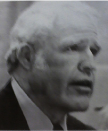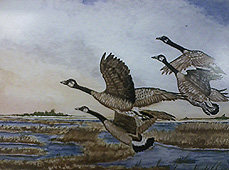By Mark Gutglueck
Howard J. Snider is a historical figure out of Ontario’s recent past.
Snider was born January 18, 1929 in Long Beach. As a kid, he shined shoes, worked in a butcher shop, hoed weeds around derricks in Signal Hill, bucked hay and sold magazines door to door. As a teenager, he raised calves and hogs. At Long Beach Polytechnic High he was on the varsity football team.
His mother hailed from Iowa and, given his interest in agriculture, he matriculated at Iowa State University. He majored in animal husbandry and competed in the 167 pound division on the wrestling team, of which he was captain. In his summers away from college back in California, he worked construction in the Long Beach area.
He attended officer candidate courses at Iowa State. Upon graduating in 1951, he married his wife, Lois, and joined the Marines. He served as a 1st Lieutenant and company commander at the Marine Corps training station in San Diego during the Korean War.
Based on his degree, he was offered a job teaching hog raising at Cal Poly San Luis Obisbo, a job which paid $325 per month. While in San Luis Obisbo, he also had a hog farm of his own.
In 1955 he came to Chino to raise hogs on a farm there, and shortly thereafter purchased a home in Ontario for $14,000. In 1957 he took up selling new cars at De Anza Chevrolet in Riverside. Simultaneously, he created a company, S & H Green Feed, which grew green alfalfa. In the very early 1960s, he went to work for Bateman Eichler Hill Richards, Inc as a stockbroker, eventually rising to become the vice president and resident manager of the local office.
In 1962 he was appointed to the city council to fill a vacancy and in 1964 was elected to a full four year term on that body. He did not serve that entire term, however, instead running successfully for mayor in 1966. He was reelected mayor in 1970.
As mayor, he supported commercial and residential development. He said, with some degree of hyperbole, that while he was mayor the city transformed itself from a small farming community into a regional leader in business, trade, development, housing and employment. In reality, the city, though it had its agricultural components, was long a relatively sophisticated commercial center.
Snider was dedicated to the expansion of Ontario International Airport, the development of a master plan for commercial and economic growth and expansion of the city’s parks and recreation system.
In 1972, as a Republican, he ran against the venerable Democrat George Brown for Congress. He attacked Brown as someone who did not live in the district and he took a stand against Brown’s push to legalize marijuana. The themes of his campaign were fighting drug abuse, reducing smog, creating jobs, cutting taxes and opposing school bussing to achieve racial diversity in local schools. Snider lost the race, garnering 43.7 percent to Brown’s 56.3 percent.
In 1974, he left politics, choosing to not seek reelection as mayor. In that same time frame, he left the employ of Bateman Eichler Hill Richards, Inc. He became the director of governmental affairs with Garden State Paper Company in Pomona, essentially working as a lobbyist. By 1977, he became the representative of the Manufactured Housing Institute.
Around that time, in his late 40s, he had ballooned to 215 pounds. To lose weight, he became an avid runner, rediscovering the athleticism of his youth. He moved up to greater and greater distances, eventually running his first marathon when he was 50, at an event in Griffith Park in 1979, completing the 26 mile 385 yard distance in 3 hours 38 minutes and 8 seconds. At another marathon in Irvine in January 1980, he covered the distance in 3 hours and 30 minutes.
While training, he would commonly run from his house on Sixth Street to Euclid Avenue and go varying distances up the Euclid median, on some days into San Antonio Heights and onto the steep fire roads there. His wife, Lois, occasionally accompanied him, riding a bike.
At the Fiesta Bowl Marathon in Scottsdale, Arizona on December 5, 1981, he clocked the course in 3 hours 18 minutes and 21 seconds.
What was said to be his best time was recorded at the Boston Marathon in 1982, but the exact time has been lost to posterity. Later that year, in October, he completed a 50-mile run in a single day. That feat, unfortunately, had untoward repercussions, as he hurt the balls of his feat in the undertaking, which impacted his training over the next several months, such that when he ran in the Boston Marathon in April 1983, his time increased to 3 hours 25 minutes and 23 seconds, placing him 4,292 among the 6,600 official runners.
Though he had never particularly enjoyed eating bagels, his fellow marathoners had said he should try them because they were ideal complex carbohydrates, which can boost a runner’s performance. He began to make his own, using a recipe that involved whole wheat. In 1983, he founded the Better Baked Bagel Company in Rancho Cucamonga, which became his most lasting business legacy.
In 1986, a year after the Ontario City Council deeded the Ontario Airport to the City of Los Angeles, Snider reentered the political fray, running for mayor and winning. He served for four years and ran again in 1990, but lost. It was the second, and last, loss of his political career. He retired from politics permanently thereafter.
He was socially active throughout his life. He was the district chairman of the Golden Eagle District of the Old Baldy Council of the Boy Scouts of America; on the board of directors of the Ontario-Pomona Association for Retarded Children; on the board of directors of the United Fund, he was chairman of the city-county coordinating committee of the county’s transportation agency, known as the San Bernardino County Association of Governments; he was a trustee on the board for the First Baptist Church in Pomona; a member of American Legion Post 112; a member of the Masonic Lodge; active in the Native Sons of the Golden West; the Ontario PTA; Kiwanis Club and the Ontario Chamber of Commerce. He held a membership in the Construction and Shipyard Laborers Union, Local 507.
Relatively late in life he took up painting, gravitating primarily to landscape and nature subjects, sometimes traveling to the mountains, the river or places like Yosemite for inspiration. He had some of his work published on postcards under the label Painting by the Mayor.
His wife, Lois, predeceased him by 19 years, dying in July 1993.
Howard Snider died in September 2012 at the age of 83. He was survived by his daughter, Sharon Speer; son, Joshua Joseph; and grandchildren, Coltrane Snider, Austin Speer, Kathryn Speer and Laine Speer.


